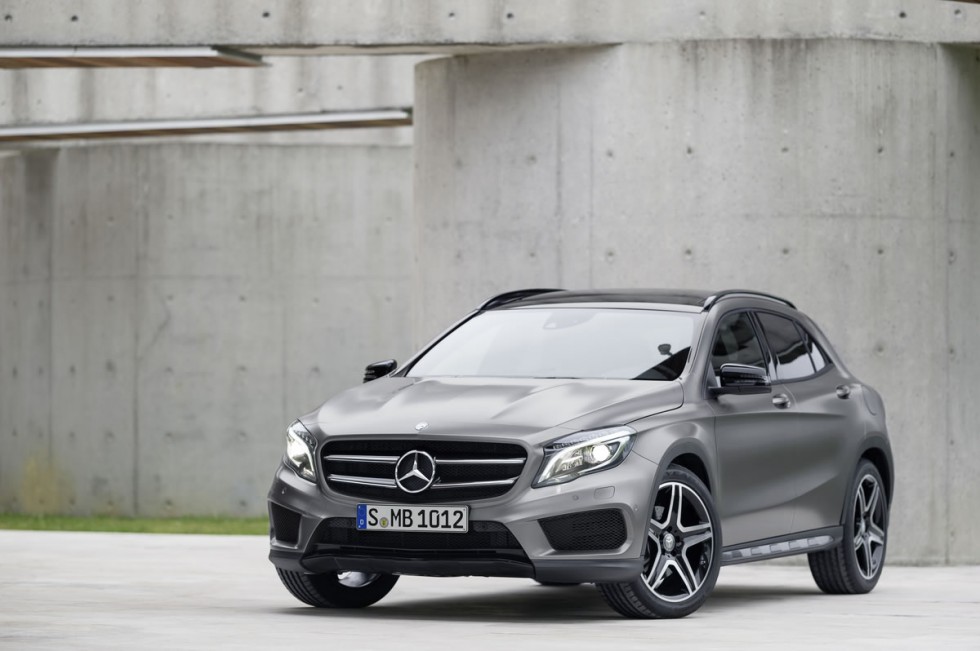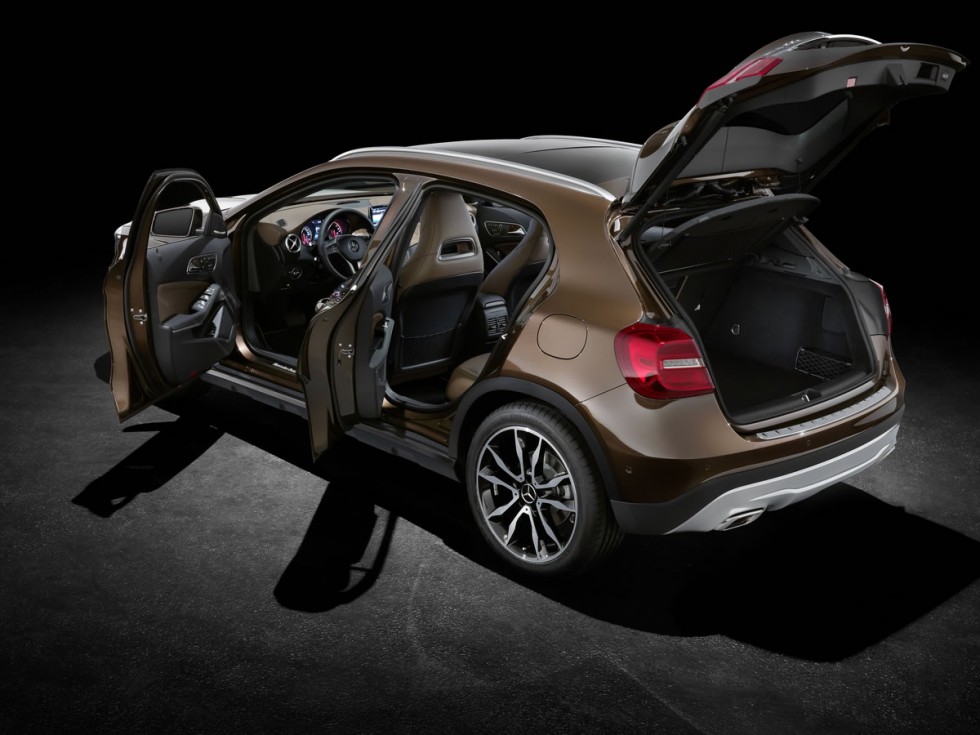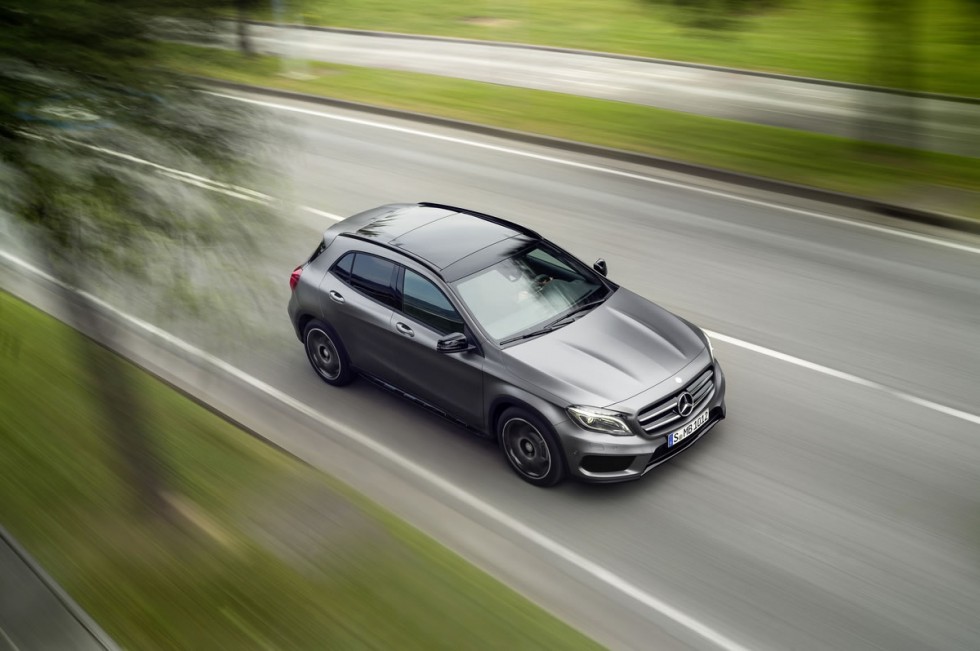Mercedes-Benz CLA, GLA and B-Class Receive a New Engine and Upgrades
Mercedes-Benz CLA, GLA and B-Class will receive new engine variants and new equipment options
Mercedes has announced the GLA, CLA and B-Class will receive a a series of updates.
To start, the models can all be equipped with an adaptive damping suspension and a DYNAMIC SELECT system that offers four different modes: Comfort, Sport, Eco and Individual (the GLA also has an off-road setting). Apple CarPlay and MirrorLink compatibility will also be available beginning early next year.
Accelerating from 0-100 km/h (0-62 mph) in 10.6 seconds before hitting a top speed of 190 km/h (118 mph) will now be possible on a new entry-level B 160 that has been fitted with a 1.6-liter four-cylinder engine that develops 102 PS (75 kW) and 180 Nm (132 lb-ft) of torque.
aThere’s also a new B 180 d BlueEFFICIENCY Edition which has a 1.5-liter (1461cc) four-cylinder diesel engine that develops 109 PS (80 kW) and 260 Nm (191 lb-ft) of torque. The engine allows the car to run from 0-100 km/h in 11.6 seconds before hitting a top speed of 189 km/h (117 mph). More importantly, the model returns 3.6 L/100km with CO2 emissions of 94 g/km.
The CLA Shooting Brake is being offered in three new variants including the CLA 180 d, CLA 200 d 4MATIC and CLA 220 d 4MATIC. The CLA 250 Sport and CLA 250 Sport 4MATIC also gain an upgraded engine that produces an additional 7 PS (5 kW).
And lastly, the GLA 220 d receives an additional 7 PS (5 kW). Allowing the entry-level crossover to accelerate from 0-100 km/h in 7.7 seconds before hitting a top speed of 223 km/h (138 mph).
Carlsson Tunes the Mercedes GLA
Carlsson Has a Go at Making the Mercedes-Benz GLA More Aggressive
Carlsson has released its interpretation of the Mercedes-Benz GLA crossover, with the German tuning company offering exterior and interior upgrades as well as performance kits.

Carlsson Has a Go at Making the Mercedes-Benz GLA More Aggressive
The aerodynamic components are adapted to vehicles wearing the AMG Sports package and enhance the Mercedes GLA’s looks thanks to the front bumper with three-piece stainless steel grille insert, four chromed oval tailpipes integrated into the rear diffuser and alloy wheels between 18 and 20 inches. There’s also a 21-inch Ultra Light model available with 265/30 R21 tires.
Other visual changes include the Carlsson horse logo replacing Mercedes’ star as well as gloss black mirror caps and roof rails.
For the interior, Carlsson offers the Signature Line leather treatment which includes numerous types of leather and colors as well as skins with embossed or imprinted Carlsson logo. Other upgrades include scuff plates with illuminated Carlsson logo on the driver and passenger side, aluminum door lock pins and pedal covers with Carlsson logo, black soft suede floor mats and more.
Performance upgrades are offered for two of the petrol models. The GLA 200 sees its output rise to 187PS (up from 156PS) and peak torque climb to 300 Nm (221 lb-ft) of torque, up from 250 Nm (185 lb-ft). The GLA 250 also gets a power boost from 211PS to 253PS, with torque increasing from 350 Nm (258 lb-ft) to 420 Nm (310 lb-ft).
Via: Carscoops
BRABUS Refines the GLA AMG
BRABUS has developed a tailor-made refinement program for the GLA AMG
The Mercedes GLA-Class is not only the smallest SUV from the brand, but in the sports version and as the GLA 45 AMG sets some remarkably dynamic highlights. Expand on these talents, BRABUS has developed a tailor-made refinement program for the five-door car.

BRABUS Program for the Mercedes GLA-Class
with AMG bodystyling kit
The product range includes engine tuning for the various diesel- and gasoline-powered models culminating in the 294-kW / 400-horsepower version for the GLA 45, aerodynamic-enhancement components, and tailor-made BRABUS Monoblock wheels with diameters of up to 21 inches that give the crossover vehicle an even more athletic appearance.
BRABUS offers the PowerXtra B25 performance kit for the four-cylinder turbocharged engine of the GLA 250 with front- or all-wheel drive. The plug-and-play module is integrated into the engine electronics. The new parameters for the engine management system and boost pressure control bumps the power output from standard 155 kW / 211 horsepower to 180 kW / 245 horsepower (208 to 241 bhp). At the same time, peak torque jumps from 350 to 385 Nm (258 to 284 lb-ft). This results in noticeably improved driving dynamics and driving fun. The sprint time from rest to 100 km/h (62 mph) is shortened to 6.7 seconds, the top speed increases to 250 km/h (155 mph).
The array of engine tuning for the compact SUV is crowned by the BRABUS PowerXtra CGI B45 tuning kit for the GLA 45. After the conversion, the top-of-the-line GLA model churns out 294 kW / 400 horsepower (394 bhp) and produces a peak torque of 500 Nm (369 lb-ft). With this engine under the hood, the all-wheel-drive car sprints from 0 to 100 km/h (62 mph) in just 4.4 seconds. In conjunction with the BRABUS V/max unit, the power-SUV reaches a top speed of 270 km/h (168 mph).

BRABUS Program for the Mercedes GLA-Class
with AMG bodystyling kit
BRABUS ECO PowerXtra D3 is the name of particularly efficient performance tuning for the common-rail turbodiesel engine of the Mercedes GLA 220 CDI. The installation of this plug-and-play auxiliary control unit delivers an extra 30 kW / 40 horsepower (40 bhp). Propelled by 155 kW / 210 horsepower (208 bhp) and a peak torque of 410 Nm (302 lb-ft), the agile diesel model sprints from 0 – 100 km/h (62 mph) in just 8.0 seconds and reaches a new top speed of 220 km/h (137 mph).
The BRABUS sports stainless-steel quad exhaust is available for almost all GLA gasoline and diesel engines. The exhaust system produces a sportier but never obtrusive exhaust note. A BRABUS sports exhaust with actively controlled butterfly valve is optionally available for the GLA 250 4MATIC. It offers the driver an individual sound tuning between subtle and decidedly sporty at the push of a button in the cockpit.
A diffusor insert for the rear bumper of the sporty GLA models with AMG body styling matches the BRABUS sports exhaust system and features tailor-made cutouts for the four chrome tailpipes with hallmark design. The front of the AMG Line version can be upgraded with a BRABUS front spoiler and design elements for the air intakes in the front bumper. It goes without saying that the BRABUS product lineup also features body styling components for the other design and equipment lines of the Mercedes GLA-Class.
The BRABUS engineers and technicians have developed LED underfloor lighting for all versions to make getting in and out easier and safer in the dark. It is activated with the keyless remote or by pulling on a door handle. The BRABUS rear spoiler, which mounts to the liftgate, can likewise be used universally on all GLA models.
BRABUS alloy wheels in OEM quality play a crucial role in the exclusive looks of the GLA refined by BRABUS. The spectrum of tailor-made tire/wheel combinations ranges in diameter from 18 to 21 inches.

BRABUS Program for the Mercedes GLA-Class
with AMG bodystyling kit
The largest option for the compact SUV features forged BRABUS 9Jx21 “Platinum Edition” wheels in the two striking Monoblock F and R designs. BRABUS technology partners Continental, Pirelli and YOKOHAMA supply the matching high-performance tires up to size 255/30 R 21 front and back.
BRABUS sports springs lower the ride height of the GLA by about 25 millimeters (1 inch). The lower center of gravity results in even sportier handling. Customers looking for a lifted suspension in the interest of more comfortable ingress and egress as well as further optimized visibility will find a suspension solution specifically designed for them that raises the ride height of the GLA by about 30 millimeters (1.2 in.).
BRABUS also fulfills all kinds of individual requests when it comes to the interior. The lineup of exclusive accessories ranges from two-tone stainless-steel scuff plates with optionally backlit BRABUS logo to matt anodized pedals and door lock pins, to aluminum ‘Race’ shift paddles.
The BRABUS upholstery shop offers even more variety. In line with the customer’s requests the upholsterers can complete the ex-factory leather interior appointments or craft completely new and particularly exclusive BRABUS fine leather interiors for which they use especially soft yet extremely durable BRABUS Mastik leather and Alcantara in any desired color.
In-Depth: Mercedes GLA45 AMG
Mercedes GLA45 AMG with the most powerful series-production four-cylinder engine in the world puts 355 hp of power and 332 lb-ft of torque on the road
Mercedes-AMG rigorously continues its product initiative: with the new GLA45 AMG the performance brand of Mercedes-Benz makes a dynamic statement in the strongly growing segment of compact SUVs. The combination of powerful-distinctive design, exclusive appointments as well as superior engine power and driving performance is unique: the most powerful series-production four-cylinder engine in the world puts 355 hp of power and 332 lb-ft of torque on the road.

2015 Mercedes GLA45 AMG
The GLA45 AMG also holds pole position with regard to driving dynamics: it accelerates from zero to 0-60 mph in 4.8 seconds and reaches a top speed of 155 mph (electronically limited). Thanks to the combination of standard AMG Performance 4MATIC all-wheel drive and AMG SPEEDSHIFT DCT 7-speed dual- clutch sports transmission, the GLA45 AMG impresses with its equally sporty and efficient drive system concept.
Tobias Moers, Chairman of the Management Board at Mercedes-AMG GmbH: “The response to the Concept GLA45 AMG during the world premiere at the Los Angeles International Auto Show has reaffirmed our decision to launch this new AMG model. Currently no segment is growing faster than that of compact SUVs. For Mercedes-AMG it is therefore logical to make a dynamic statement in this segment with the GLA45 AMG. Our new high-performance-SUV not only offers the world’s most powerful series-production four-cylinder engine, but also impressively low fuel consumption and emissions figures. Not least on account of the performance-oriented AMG 4MATIC four wheel drive, the GLA45 AMG is a true AMG when it comes to driving dynamics.”
Young target group: styling, dynamics and independence
In addition to the CLA45 AMG, the GLA45 AMG is the second vehicle with a four-cylinder turbo engine to appeal to a young target group. Customers take a great interest in styling, dynamics and independence – traits that are perfectly embodied in the new high-performance SUV from Affalterbach. Meeting a wide variety of customer desires has always been one of the strengths of Mercedes- AMG. The GLA45 AMG now expands the extensive high-performance SUV lineup to four models in the U.S. (GLA45 AMG, ML63 AMG, GL63 AMG, and G63 AMG). Mercedes-AMG thus offers the widest range of SUVs among all high-performance premium brands.

2015 Mercedes GLA45 AMG
Hallmark AMG features: the world’s most powerful series-produced four- cylinder engine
Best in class: the GLA45 AMG engine fully lives up to this claim, as a look at the figures shows. The AMG 2.0-liter turbo engine is the most powerful series- production four-cylinder turbo engine in the world. It produces 355 hp of power and develops a peak torque of 332 lb-ft. A power output of 178 hp per liter puts the AMG high-performance turbo engine on a par with the world’s most powerful super sports cars.
Development of the high-performance turbo engine placed emphasis on a sustainable reduction in exhaust emissions. The AMG 2.0-liter four-cylinder turbo engine features spray-guided direct petrol injection with piezo injectors positioned centrally in the four combustion chambers and an injection pressure of up to 2900psi. The combination of multiple fuel injection pulses and multiple spark ignition system improves fuel economy and thermodynamic efficiency, leading to low exhaust emissions. The injection system’s outstanding flexibility also ensures a high degree of freedom in terms of application. There are up to five injections per combustion cycle in the cold-start and warm-up phase, which is crucial for emissions.
Further highlights of the AMG 2.0-liter four-cylinder turbo engine:
- Sandcast all-aluminum crankcase
- Lightweight forged steel crankshaft
- Forged pistons with friction-optimized piston rings
- NANOSLIDE cylinder liner technology
- Air-to-water intercooling system with separate cooling circuit
- Alternator management
- ECO start/stop function
- Twin-scroll turbocharger and AMG sports exhaust system with variable vane
Mercedes-AMG addresses the basic challenge with regard to the throttle response of a small-capacity turbo engine by using a twin-scroll turbocharger, maximum de-throttling of the exhaust system and an innovative injection strategy. Twin-scroll technology provides a more spontaneous build-up of charge pressure: utilization of the exhaust back-pressure, exhaust-gas temperature and exhaust-gas pulse has a positive impact. This results in a faster build-up of torque even at low engine speeds. A positive side-effect: fuel consumption and exhaust emissions also benefit from twin-scroll technology. With a maximum charge pressure of 26.1psi, the AMG 2.0-liter four-cylinder turbo engine leads the field on this front as well.
The AMG sports exhaust system in the GLA45 AMG features large pipe cross- sections and an automatically controlled viarable vane: this technology reconciles the two conflicting goals of a dynamic driving experience and hallmark Mercedes suitability for long-distance driving. The vane in the rear muffler is continuously adjusted under map control according to the driver’s performance needs, load condition and engine speed. The two rectangular chrome-plated twin tailpipes of the AMG sports exhaust system emit a fascinating exhaust note, which is particularly impressive during powerful acceleration. An AMG Performance exhaust system, also equipped with an exhaust vane, is available as an optional extra. Customers opting for this system will experience an even more appealing and distinctive engine sound.

2015 Mercedes GLA45 AMG
Engine production – a tradition of hand-built excellence
The AMG 2.0-liter four-cylinder turbo engine is assembled purely by hand in accordance with the traditional AMG philosophy of “one man, one engine”. Apart from serving as an AMG hallmark confirming superlative production quality, the AMG engine badge bearing the engine fitter’s signature also attests the peerless DNA of Mercedes-Benz’s high-performance brand.
AMG SPEEDSHIFT DCT 7-speed dual-clutch sports transmission
The AMG SPEEDSHIFT DCT 7-speed dual-clutch sports transmission in the GLA45 AMG features three distinct transmission modes, a double-declutching function dependent on the transmission mode and a RACE START function for optimum acceleration. The strengths of the dual-clutch transmission include spontaneous gear shifts without loss of tractive power, a tailor-made control strategy based on the AMG SPEEDSHIFT functions, extremely smooth gear shifts, and a high level of efficiency.
The shift times in manual mode “M” and in sport mode “S” are similarly sporty in character to those of the SLS AMG GT super sports car. Quick and precise retardation of the ignition and suppressing injection under full load lead to even faster gear shifts in “M” and “S” modes, with a more exciting exhaust sound. The transmission control fully utilizes the benefits of direct injection technology right up to the physical limits: the quicker engine response ensures that injection is suppressed with even more precision. The effect: the shift speed and an emotional sound experience make for a fascinating ride. Another special feature designed to enhance dynamic performance and driving pleasure is the so-called “Momentary M mode” – as seen in the SLS AMG Black Series super sports car.
In “C” mode (Controlled Efficiency), smooth transmission and engine characteristics support a fuel-efficient and comfort-oriented driving style. In addition, the ECO start/stop function is active in “C” mode.
AMG Performance 4MATIC four wheel drive as standard
The GLA45 AMG comes with variable AMG Performance 4MATIC four-wheel drive as standard. In developing this four wheel-drive system, the focus was firmly on performance and dynamic spirit. The all-wheel-drive system transfers the engine power to the road optimally and provides perfect traction. It also elevates driving dynamics to the highest level.
The entire drive system boasts a weight-saving and compact design: the power take-off unit (PTU) is fully integrated into the 7-speed dual-clutch sports transmission and handles the power transfer to the rear drivetrain via a two- part propeller shaft. In the interests of favorable weight distribution, an electro- hydraulically controlled multiple-disc clutch is integral with the rear-axle differential. A hydraulic pump instantaneously presses the discs together and channels the engine torque to the rear wheels as necessary. All this goes unnoticed by the driver. Power distribution is fully variable: during normal driving the GLA45 AMG uses front-wheel drive for optimal efficiency. Where needed, the variable four-wheel-drive system splits the torque between the front and rear axles at a ratio of up to 50:50 percent.
As with other AMG models, the Electronic Stability Program is configured as a three-stage ESP®. The GLA45 AMG comes with three transmission modes: “ESP ON”, “SPORT Handling Mode” and “ESP OFF” – enabling the driver to vary dynamic performance according to individual requirements at the push of a button. ESP® Curve Dynamic Assist (torque vectoring) is likewise included as standard. During dynamic cornering, imperceptible braking interventions on the rear inside wheel create a defined yaw moment about the vertical axis. The effect: the GLA45 AMG turns in precisely and controllably at all times while unwelcome understeer is prevented.

2015 Mercedes GLA45 AMG
AMG sports suspension and AMG high-performance braking system
One of the keys to agile handling is axle technology: for enhanced driving dynamics, the McPherson front axle on the GLA45 AMG is fitted with stiffer steering knuckles and new elastokinematics. The four-link rear axle has also been newly developed. Stability and precision of handling are enhanced by the optimized elastokinematics and the rigid connection between the subframe and the body. The AMG sports suspension with specially tuned spring/damper units and bigger anti-roll bars ensures high lateral acceleration and reduced body roll when driving fast on winding roads. An AMG performance suspension with firmer spring and damper tuning is available as an optional extra.
The AMG speed-sensitive sports steering with specific, speed-dependent power assist ensures high steering precision and agility. The AMG high-performance braking system with vented, perforated brake discs all-round and gray-painted brake calipers delivers spontaneous and reliable deceleration. Red brake calipers are available as an optional extra.
Three attractive AMG alloy wheels to choose from
In standard specification the GLA45 AMG runs on 5-twin-spoke 19″ AMG alloy wheels painted titanium gray with high-sheen finish, mounted with tires of size 235/45 R 19. As an optional extra, customers can opt for larger 10-spoke 20″ AMG alloy wheels with tires of size 235/40 R 20 – these are available painted titanium gray with high-sheen finish or painted matte black with high- sheen rim flange.
Powerful and distinctive: sensual clarity with AMG character
The design of the GLA45 AMG exudes fascination on account of its powerful and distinctive character. As the powerful AMG top-of-the-line model of the GLA class, the high-performance compact SUV combines the hallmark sensual clarity of Mercedes-Benz as an expression of modern luxury with muscular elements exclusive to AMG. The AMG front fascia with front splitter and the AMG “twin blade” radiator grille provide athletic highlights – both are painted matte titanium gray. Completely new: the distinctive AMG logo at the side between the blades of the radiator grille. This will make all new AMG models easy to recognize in the future. Black flics (air deflector elements) above the large cooling air intakes at the sides pay homage to motor sport. Bi-xenon headlights come as standard.
When viewed from the side, the distinctive AMG alloy wheels in three design options certainly catch the eye. The side sill panels with matte titanium gray inserts, the “TURBO AMG” lettering on the front fenders and the aluminum roof rails lend the GLA45 AMG a special touch. The rear end is dominated by the diffuser insert with titanium gray trim and the rectangular, chrome-plated trim of the twin tailpipes of the AMG sports exhaust system with its variable exhaust vane.

2015 Mercedes GLA45 AMG
The following AMG equipment features can optionally upgrade the exterior design:
- AMG Aerodynamics package: larger front splitter, additional flics on the front fascia, rear roof spoiler, and select Night Styling elements package
- Exterior Carbon-Fiber package: carbon-fiber front splitter, side sill panel insert and rear fascia trim, Carbon-fiber exterior mirror housings
- Rear roof spoiler
- AMG Night Styling package: high-gloss black front splitter, exterior mirrors, window frames, roof rails, side sill panel insert and rear fascia trim, two tailpipes with in black chrome with black
- rectangular trim
- Red painted brake calipers with black AMG lettering
- Interior design: high-quality, sporty, exclusive
As in all AMG high-performance automobiles, the interior of the GLA45 AMG delights with its high-quality appeal combined with sporty flair and exclusive equipment features. These include sports seats upholstered with MB-Tex man- made leather/DINAMICA microfiber with red contrasting topstitching and red designo safety belts. The 3-spoke nappa leather multifunction sports steering wheel with red contrasting topstitching, perforated leather in the grip area and steering-wheel shift paddles ensures perfect vehicle control. The AMG instrument cluster with 2-tube design and central color display, AMG main menu and RACETIMER is on hand to keep the driver up to date. On opening the door, the driver is greeted by the AMG start-up screen in the center of the cluster. The trim of the instrument panel is made from brushed aluminum and, in tandem with the brushed stainless-steel AMG front door sills, emphasizes the high-grade, exclusive ambiance inside the GLA45 AMG.
The interior can be upgraded with the following AMG optional extras:
- Performance steering wheel in black nappa leather/Alcantara®
- Performance seats by Recaro upholstered in leather or MB-Tex man-made leather/DINAMICA microfiber or 4 optional leather covers for driver and front passenger, with more strongly contoured seat
- shape for enhanced lateral support and with integral head restraints
- Carbon-fiber Trim, Satin Brown Polar Wood Trim, Burl Walnut Wood Trim
- Leather upholstry in black, ash gray, nut brown or black ‘Red Cut’ design
Mercedes-Benz GLA 220 CDI Review
The Mercedes-Benz GLA 220 CDI is the perfect rival for the Audi Allroad
Tom Phillips from Auto Express recently took out and test the Mercedes-Benz GLA 220 CDI and this is what he had to say.
Mercedes calls the GLA a compact SUV. But while it’s pegged as a rival for the Audi Q3 and BMW X1, it seems much less rugged– more like an Audi Allroad, or – whisper it – a Rover Streetwise. All that sets its exterior apart from an A-Class is a little plastic cladding, some roof rails, and chunkier bumpers, although, to be fair, the GLA appears quite a bit bigger than its sister car in the metal, and noticeably higher-riding, but it’s a soft-roader at its softest.
Inside, you still drop down into the driver’s seat, even though it’s mounted higher than in an A-Class. That also means you don’t truly benefit from the commanding driving position that SUV buyers covet. It also takes some time to get the seat and wheel set in a comfortable position, but once you’ve got it right, visibility is pretty good.

Mercedes-Benz GLA 220 CDI
The GLA’s ride is much more comfortable than the overly firm A-Class, even with the sports suspension on our test car. The taller tyres and raised ride height over the A-Class mean the GLA is more able to soak up bumps in the road, although if you opt for the larger 19-inch wheels, the ride gets a bit jiggly.
The steering is OK initially – it’s light and has quite a mechanical clunky feel just off centre, as the power steering motor wakes up to give its electric assistance. But as you built the lock up, weight is added artificially, so it feels like you’re winding a rubber band up with the steering wheel, rather than driving a car.
That said, although there isn’t a great deal of feel, the steering is pretty direct and the car responds quite quickly to your inputs, although the softer setup means the GLA’s body floats around a lot more than an A-Class’s does. But that’s a trade-off that’s definitely worth making, as the GLA is much more comfortable as a result.
When you accelerate, grip is good – the predominantly front-wheel drive transmission can send up to 50 per cent of torque to the rear wheels if needed. This gives plenty of reassurance, even on really wet roads, helped by the brakes doing a pretty decent job of slowing the car’s 1,535kg weight.
As in other Mercedes models, the 2.1-litre diesel is a strong performer, but it’s still really coarse and noisy right across the rev range, and is only silenced when you pull up and the stop-start system kicks in. The seven-speed dual clutch gearbox is smooth when you’re cruising, but again it’s let down by the fact it doesn’t seem to be able to pick the right gear in a way that Audi’s S tronic or BMW’s auto does.

Mercedes-Benz GLA 220 CDI
While it isn’t overtly SUV-looking, the GLA is more practical than an A-Class, with a bigger boot and more rear-seat room, although the low roofline does limit the view out for taller back-seat passengers. The boot is over 40 per cent bigger than an A-Class, and it does look quite sporty, too, especially in the AMG Line-spec tested here.
It’s very much on-road biased, but its ride height increase, plus tech like hill descent control, means it’ll take on a churned-up gravel trail alright, as long as you take it easy.
All of which means the GLA has a sporty look, better practicality than an A-Class, and the ability to take on some light off-roading. So it just about qualifies as an SUV, even if it looks like something rather less rugged, and it certainly adds a level of comfort and space that makes it well worth the extra if you’re considering an A-Class.
What is the verdict? Head over to Auto Express to find out.
Mercedes-Benz GLA Review – Video
The Mercedes GLA might be referred to as a small SUV, but really it looks more like a larger, more comfortable version of the A-Class
Our friends across the Atlantic took the mighty, yet mini, Mercedes GLA and GLA45 AMG on and off-road. So what did the guys over at AutoExpress think of Mercedes’ newest SUV? Watch the video and check out their review below.
The Mercedes GLA might be referred to as a small SUV, but really it looks more like a larger, more comfortable version of the A-Class. It’s taller than the hatchback it’s based on, but is actually much smaller than the Audi Q3.
The GLA’s comfortable and refined ride rights our main complaint about the fidgety and sometimes uncomfortable A-Class.
It’s not at the expense of handling either. There’s more bodyroll than the A-Class, but not enough to stop you having fun, and the steering is sharp too.
We’d go for the diesel versions, which do lose some refinement, but the improved running costs do sweeten the deal somewhat. The Automatic gearbox is pretty good, but you might want to think about going for the manual instead.
Although most customers will go for the standard petrol and diesel models and never take it off-road, for those wanting something extra it does have another couple of strings in its bow.
Later this year you’ll be able to buy a special off-road pack for the GLA , which adds a few basic off-loading features to help traverse muddy fields or bumpy dirt tracks.
If you prefer something quicker, AMG has worked its magic, too. Like the A45 and CLA 45, the GLA 45 AMG features a 355bhp 2.0 turbocharged engine. It’s a bit slower to 60 thanks to the higher weight, but in reality you’ll never really feel the difference.
In the end apart from a comfier ride and basic of-road ability, the Mercedes GLA is mainly about the extra space – the boot is 40% bigger than that of the A-Class. Forget was Mercedes say, think of it less as an SUV and more as an A-Class estate.
How the New Mercedes-Benz GLA Was Tested
24 Mercedes GLA models completed this marathon and other endurance tests, racking up over 1.1 million miles in the process
The new GLA-Class has successfully completed an endurance trial which, in addition to on-road testing, additionally takes in the stresses and strains typical of off-road all-wheel-drive use. In the course of this track & field endurance trial extending over some nine months, a vehicle’s entire subsequent lifespan in the customer’s hands is simulated at time-lapse speed to verify the GLA’s fitness for series production. In all, 24 GLA models completed this marathon and other endurance tests, racking up a total of over 1.1 million miles in the process.
The focus of the tests in this nine-month GLA marathon was on durability and the reliable operation of the new 4MATIC all-wheel drivetrain, the suspension and the electrical equipment such as the comfort, control and assistance systems. In addition, the track & field test ensures the strength and durability of the entire structure of the SUV bodyshell.

Mercedes-Benz GLA Off-Road Testing
Collection of comprehensive data provides detailed insights
Simulating the entire lifespan of a vehicle within nine months requires a defined load scenario which the test engineers realise with different “load collectives”. The track & field endurance test includes extensive drives on country roads, motorways or in inner-city stop-and-go traffic – disciplines familiar from the conventional road endurance testing programme covering 150,000 kilometres. In part, these stretches are covered by the GLA test vehicles towing a trailer with the maximum allowable towing capacity; this is intended to further intensify the structural loads on the body. But the distance of 1.8 million kilometres covered by the 24 GLA long-distance runners only partially reflects the scope of the test disciplines. In the track & field endurance test the test drivers also check all the controls and operating devices according to an exactly defined procedure.
Always on board with the test driver: the computer to record all the data. It continuously records 190 different measured variables for the standard-fit monitoring and control systems and some 50 variables for additionally installed sensors. In the course of testing, at the end of their shifts the test drivers either link up to specific Daimler in-house access points which transfer the data fully automatically to the Mercedes-Benz Technology Center (MTC) for safe storage and evaluation or, when no access points are available, they save the data on a mobile storage medium for evaluation at a later juncture. So-called pen tops are also used. These serve to provide the test drivers with precise details of the specified test programme. All the events occurring on the test drives are also documented in this system. In particular, subjective impressions of the experienced drivers help to further enhance production maturity.
All information is managed with Daimler’s own development tool FINAS (Vehicle Information and Administration System). Here the complete vita of the GLA prototypes with all measured data and vehicle-specific information such as stage of development, equipment, chassis, tyres or engine are saved, and pending or performed service or repair work is entered.
In each GLA endurance trial the test engineers obtain around 1.8 gigabytes of measurement data, which they evaluate in detail in the course of the track & field endurance trial. This enables them to assess the state of the vehicle and to identify any signs of faults in good time. When faults are identified, a standardised task force procedure involving all the relevant departments comes into effect, ensuring precise diagnosis and reliable remedial action.
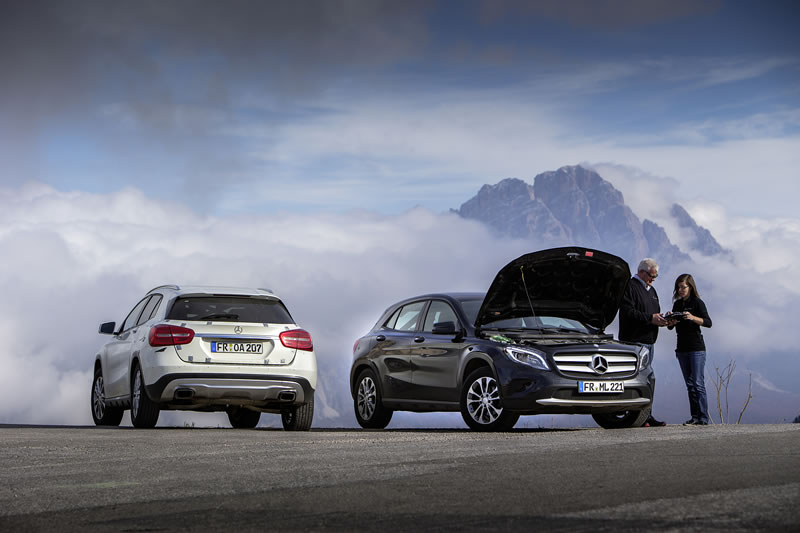
Mercedes-Benz GLA Mountain Testing
Aggravated conditions: Nürburgring, Alps, tank practice grounds
The notorious endurance runs on the world’s toughest race track – the Nürburgring Nordschleife – are well known. A one-kilometre sprint is equivalent to 20 kilometres in the real life of an automobile. And the GLA has to complete 240 laps or around 6000 kilometres here. This means the time spent at the Nürburgring adds up to the equivalent of 100,000 “real” kilometres. As these hot laps involve an element of danger, the endurance test vehicles are equipped with a roll-over cage. The endurance tests in an Alpine environment are similarly demanding. One stretch in the Italian Alps is a veritable helter-skelter ride, with one stage of the test along a distance of 154 kilometres taking in 9 Alpine passes and 450 bends. A difference in elevation of 4300 metres also has to be overcome, and the overall test distance on this track after 20 laps totals 3080 kilometres. The numerous winding bends impose a particular strain on both the chassis and the 4MATIC drivetrain as the vehicle accelerates out of the bends, and ensure that the dynamic handling control systems have their work cut out.
In view of its lineage, Mercedes-Benz requires the new compact SUV to prove its mettle off the beaten track too. After all, in deference to the G-Class – the grandfather of all SUVs and cross-country vehicles with the star – only those vehicles that also meet certain minimum requirements off-road may carry a “G” in their name. To ensure this, the track & field endurance test includes a run that very freely construes the term “primitive road” – the so-called tank ring road of a military training area of the German Armed Forces in southern Germany. Where giant chain-driven 62-tonne vehicles rated at 1103 kW (1500 hp) are normally to be found making their way to the various training areas, churning up the unpaved ground below them as they go, the GLA is required to demonstrate over 1000 kilometres that it is able to stand up to such adverse conditions on a sustained basis.
The sequence of tests plays an important role in the track & field endurance test, as it would make no sense to work successively through each test discipline in isolation. Rather, the track & field endurance test is aligned with the real-life demands placed on an SUV in the customer’s hands. The individual on and off-road disciplines are broken down into test cycles which are completed in varied patterns according to a defined distribution scheme. For instance, a drive over country roads may be followed by an off-road excursion, or a city drive may be followed by a long stretch of motorway, just like in real life.
To cover various load scenarios for a customer-owned vehicle, in addition a number of disciplines involve different loads. For this purpose, either steel bars are firmly screwed to the vehicle floor in the rear, or the test drivers are accompanied by “water boys”: water-filled plastic torsos weighing 82 kilograms, strapped to the seats with standard seat belts.
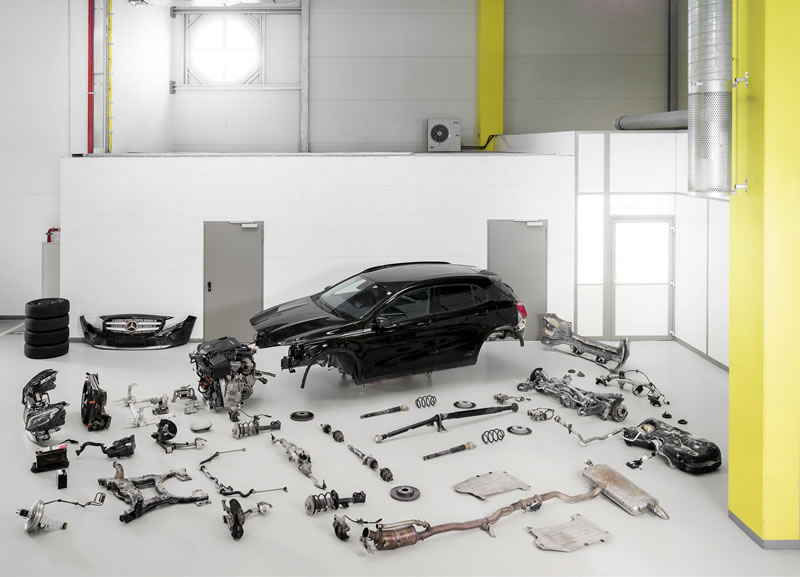
Mercedes-Benz GLA Testing
Grand finale with complete dismantling and detailed assessment
Before the various professional journals worldwide set about examining the solidity and reliability of the SUVs from Mercedes-Benz in endurance tests which generally cover over 100,000 kilometres, the test engineers have already performed this task a couple of dozen times – including complete dismantling. After completing track & field endurance testing, the GLA models are disassembled and their individual components are spread out like an automotive puzzle. Behind closed doors the development and test engineers of the specialist departments subsequently evaluate all vehicle components, focussing on those areas where any anomalies have been observed during the endurance tests and addressed by the above-mentioned task force. If no further nonconformances are found in these sections, their fitness for series production can be certified. However, if further problems, or previously undiscovered problems arise, the task force will go into action again until they find a perfect solution. If in doubt, GLA endurance test subjects are sent on their rounds again and the tests on devices such as the body testing facility or the road simulation test rig are intensified. After the closed-door meetings over the disassembled GLA, further assessments follow: in the appropriate development units the engine, transmission and 4MATIC drivetrain are then completely disassembled, measured and scrutinised.
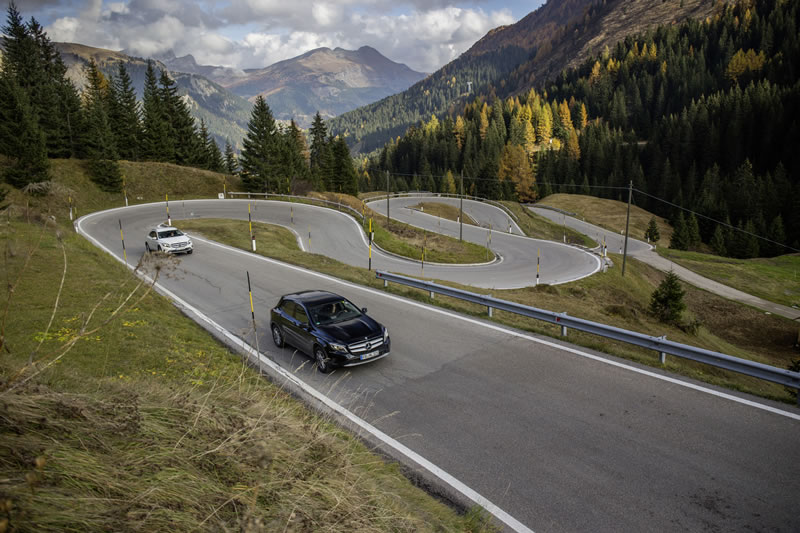
Mercedes-Benz GLA Endurance Testing
Track & field endurance test: one of many
The track & field endurance test rounds off the extensive endurance testing programme carried out worldwide by Mercedes-Benz. This endurance testing programme differs fundamentally from the development and tuning runs performed on new models; these are done additionally. Whereas on these runs the characteristics laid down in the specifications book are verified, programmes like the track & field endurance test verify the reliability and durability of new models.
During the trials such as the road endurance test over 150,000 kilometres or the track & field endurance test over 80,000 kilometres, in which the focus is on the vehicle as a whole, the development engineers also carry out additional, specialised endurance tests:
- World endurance test: 50,000 km worldwide in extreme climatic and topographic conditions
- Trailer endurance test: 25,000 km with a special loaded trailer
- Rough road endurance test: 2000 km over extremely rough roads (“Heide” endurance test)
- Corrosion endurance test: 12-week testing in climate and corrosion chambers and on real-life routes
- Function tests: Checking of control systems and dynamic handling control systems on load-specific routes
- Hockenheim endurance test: 6000 km on the Grand Prix circuit at racing speed
- Full-load endurance tests over 30,000 or 50,000 km on cordoned-off high-speed tracks such as Nardo (southern Italy) or the Mercedes-Benz testing grounds in Papenburg, northern Germany
- Worldwide deployment: endurance testing in Europe, Asia and America verify fitness for series production.
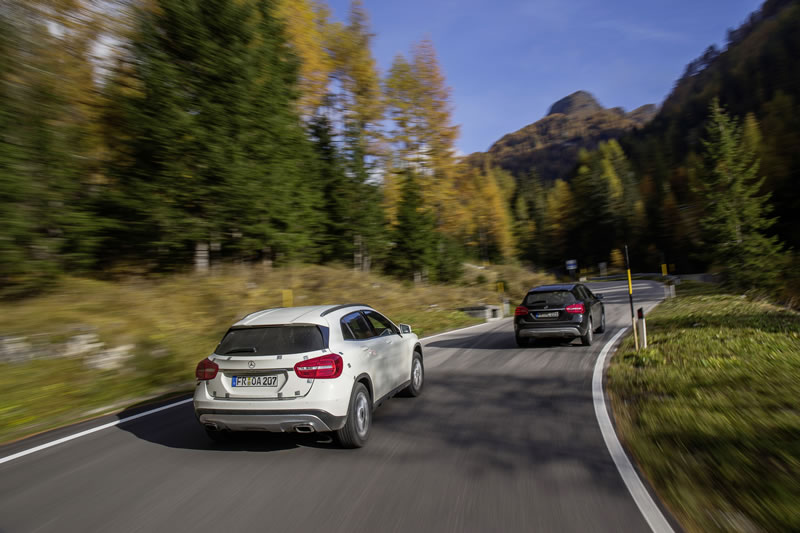
GLA-Class Endurance Test
Sound basis for maximum stability
Nürburgring Nordschleife, Karussell section: The GLA prototype with 67,245 km on the clock drops at a speed of 120 km/h from the left into the high-bank curve which is interspersed with lateral joints, jolting chassis and driver to the limit. Despite the high levels of stress and strain, the compact SUV darts relatively unspectacularly through the 180-degree turn. “No jittering bodywork, high torsional or bending strength, no creaking noises – even after almost 5000 kilometres on the Nordschleife, the GLA body continues to impress me”, the experienced track & field test driver later wrote in his daily report.
Stetten military training site, Panzerringstrasse: On the rain-drenched unsurfaced road dotted with deep ruts, potholes, twists and turns, two GLA prototypes do their rounds at speed, throwing up plenty of mud and stones in the process. The track & field candidate from the Nürburgring endurance test is also in on the action here. With 73,290 km on the clock, it is nearing the end of its testing. The tormented body nevertheless bears up admirably, as confirmed by both the driver’s assessment and the recorded measurements. “The GLA’s body copes particularly effortlessly with winding stretches”, both test drivers confirm.
Just two test days, which serve to demonstrate the high levels of stress and strain to which the GLA’s body was subjected in the track & field endurance test. After completing the tortuous 80,000 kilometres of testing, the merits of the GLA’s chassis and body are established beyond doubt and confirm that this solid basis is built to last a vehicle’s lifetime in operation by the customer, even in the toughest service conditions. The GLA has an extremely rigid body, providing the basis for stable and safe handling characteristics both on and off the road, as well as best-in-class NVH comfort and outstanding passive safety. Weighing in at 400.3 kilograms, 73 percent of the bodyshell is comprised of high-strength and ultra-high-strength steels. In the area of the side roof frame and the new C-ring structure in the rear, hot-formed steels are used – ensuring the highest strength category possible for body steels.
It was decided at the beginning of the development phase that the new GLA was to have a number of features which would raise the vehicle to a class-leading position in terms of comfort, sense of spaciousness and practical attributes. Two aspects posed special challenges for the engineers with regard to the body: neither the very large roof opening nor the wide tailgate opening were to have any negative effect on stability and rigidity.
The GLA offers by far the largest glass roof in its class, with glass covering 64 percent of the roof surface area. As such, this feature guarantees a generous, light and airy feeling of spaciousness, thus enhancing comfort in both the front and rear.
As a result of this feature, the roof bows which are otherwise customary in this area had to be replaced by an appropriate construction in order to keep the torsional stiffness of the body at the same level as with a closed steel roof. This was achieved with a double-skinned roof frame to support the B-pillars, an enlargement of the cross-section at the D-ring, the mentioned heat-formed steels offering the highest possible strength and the use of an extremely sturdy glass sunroof frame firmly bolted to and bonded with the body structure.
The wide tailgate opening, which facilitates easy loading even with bulky objects, required a substantially more complex solution. The engineers at the Mercedes-Benz Technology Center (MTC) developed totally new body structures here. In addition to the D-ring familiar from other models, which forms the rear end of the body, a C-ring is also employed. These two closed ring structures form an extremely stable unit and ensure excellent torsional stiffness. In addition, the two rear shock-absorber strut fixtures are supported by the C-ring. This decisively improves the resistance to forces transmitted from the rear axle connection and thus the NVH (noise, vibration, harshness) characteristics in general.
At the same time, the developers compensated the loads in the rear area of the body by means of the new spindle-type actuator of the optionally available automatic tailgate. Very high forces arise here particularly at the beginning of the automatic opening process. These are reliably absorbed by the highly robust combination of C and D-ring.
The outstanding stability of the GLA’s body-in-white will also be highlighted by the Mercedes-Benz GLA 45 AMG which is to be launched in due course. This high-power SUV with a 2.0-litre turbo engine offers an output of 265 kW (360 hp), maximum torque of 450 Newton metres and does not require any reinforcement of its body, despite its vast power.
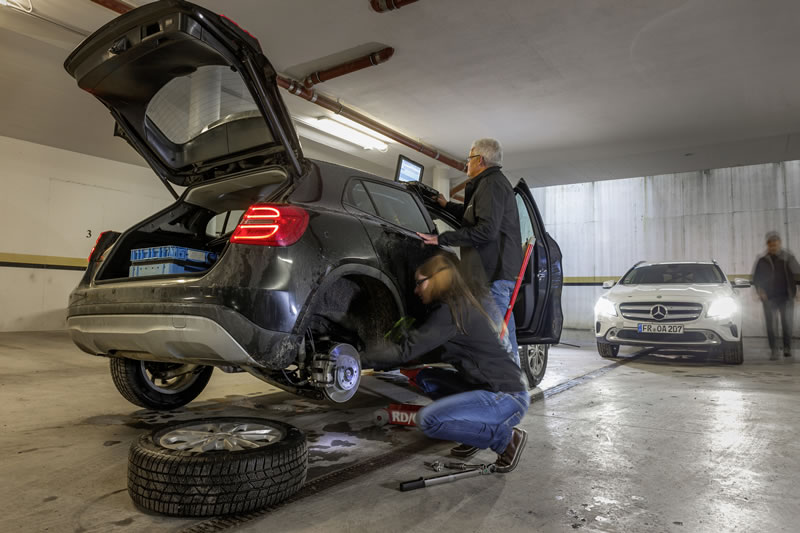
GLA-Class Endurance Test
All set for any operating conditions: 4MATIC and 7G-DCT
The new 4MATIC from Mercedes-Benz is featuring for the first time in an SUV. This permanent all-wheel drive with fully variable torque distribution is tailor-made for the compact SUV GLA, as the off-road variant of the new 4MATIC all-wheel drive based on the front-wheel-drive architecture formed an integral part of the system development process. The engineers accorded due consideration to deployment in off-road vehicles right from the earliest phases of development. On the GLA 4MATIC models and with larger wheels, higher wheel torques apply in particular in off-road use, for example. The drive shafts require to be specially adapted to the optional raised off-road comfort suspension and the resultant articulation angle in the compensating joints. Both on and off-road, the new 4MATIC harmonises outstandingly with the 7G-DCT automated dual clutch transmission.
Looking smart off the beaten track with off-road control features
Vehicles with 4MATIC feature additional off-road control functions and Downhill Speed Regulation (DSR) as standard. DSR is activated via a control button in the centre console to assist the driver on steep and demanding downhill stretches. The vehicle speed which was previously set using the cruise control lever on the steering column and is shown on the central display is maintained automatically, as far as the physical limits allow. This is done with the help of the engine and transmission control systems, and by targeted brake intervention. Conversely, the start-off assist system and the HOLD function assist the driver when starting off uphill.
As a result of the off-road functions, the transmission shift points, accelerator pedal characteristics and thresholds of the dynamic handling control systems are adapted accordingly, resulting in substantially enhanced off-road capabilities. Another useful off-road option is the off-road comfort suspension (front +30 millimetres, rear +22 millimetres). This raising of the suspension yields several advantages. The resultant increase in spring travel provides the GLA’s wheels with longer ground contact and subsequent improved traction on heavily contoured terrain. Comfort is also enhanced, and the raised seat position provides better all-round visibility, both off and on-road.

GLA-Class Endurance Test
All-round view: off-road display and off-road lights
In combination with the Audio 20 CD (standard) and COMAND Online (optional extra), an on and off-road display can also be activated on the CENTRAL MEDIA DISPLAY. The steering angle and a compass are shown in this mode. The roll angle in degrees, the gradient in percent and activation of Downhill Speed Regulation DSR are also indicated. All 4MATIC models equipped with the Intelligent Light System (ILS) also feature off-road lights, which provide for improved visibility during night-time off-road driving. When travelling at low speeds in confusing off-road terrain, the broadest and brightest possible illumination of the area in front of the vehicle is expedient to enable more effective and faster recognition of obstacles. The off-road lights go on automatically when the driver activates the off-road drive programme while the headlamps are on. To this end, the bi-xenon headlamp modules pan outwards by 6 degrees, the luminous power of the xenon burner is increased by 3 W and a symmetrical light distribution is set. In addition, the LED cornering lights on both sides are switched to permanently lit mode, while dynamic curve illumination and range adjustment are deactivated. These settings ensure broader and brighter illumination of the area directly in front of the vehicle compared with ILS, which is optimised for on-road use. This helps the driver to find their way in off-road terrain substantially more effectively and enables any obstacles to be recognised more quickly. Off-road lights are active up to a speed of 50 km/h. Once the driver exceeds this threshold, ILS automatically switches back to the light functions optimised for road use.
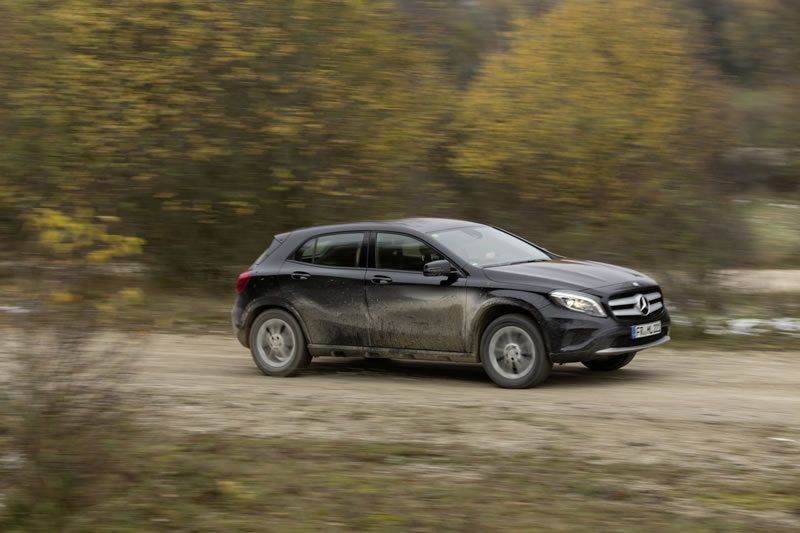
GLA-Class Endurance Test
The “Heide” test – the mother of all car endurance trials
Anyone motoring around the Lüneburg Heath at the beginning of the 1950s needed to be brave, unflinching and able to shrug off the knocks that beckoned along the way. The routes around Hollenstedt and Moisburg had very little to do with what we generally understand by the term “road”. Asphalted surfaces were extremely rare and for the most part traffic had to make do with unsurfaced roads abounding in potholes and bumps or rough cobblestones that took their toll on body, suspension and occupants alike. Reports on the state of the roads here also filtered through to Stuttgart, where the development engineers at Mercedes-Benz were always on the look-out for suitable stretches on which to test new models. Following an extensive scouting expedition to the north of the young republic, the “Heide test” became a firmly established element of the Mercedes test programme. After completing a few drives at the “Heide”, it was clear that they had chanced upon an ideal testing area. The terrain proved such a trial for body, chassis and suspension that a degree of stress and strain corresponding to a car’s entire lifespan became apparent in the space of a few weeks.
So as to avoid the successive modernisation of the Lüneburg Heide infrastructure putting an end to the test drives, the stretches were duly duplicated, giving rise to authentic copies first of all at the Mercedes test site in Untertürkheim in the mid-1960s and later also at other test locations such as Sindelfingen or Papenburg. This was no simple matter, as a report from 1967 on the extended test site in Untertürkheim reveals:
“….In transferring particularly difficult stretches to the new site, the original profile was sampled with geodetic precision using iron wheels in two lanes and then plotted on graph paper. A wooden template was then produced, from which the concrete mix was removed in a final step. In this way, a test site with an endlessly diverse range of different stretches was painstakingly created. Half of the test sections totalling 15,460 m in length were provided with decidedly awful surfaces….”
The “Heide” test thus laid the foundation of today’s extensive endurance trials in which around 350 prototypes each year are required to demonstrate their resistance to extreme stress and strain. Close synchronisation between the real-life on and off-road endurance tests throughout the world and the numerous tests carried out on test rigs such as the body testing rig guarantees even more meaningful results. While roads such as those in the Lüneburg Heide around 1950 are very rarely to be found in central Europe today, the GLA is an SUV with off-road capabilities. This means that it is still required to stand up to test runs in conditions corresponding to those in the Lüneburg Heide shortly after the Second World War. In keeping with Mercedes-Benz’s philosophy on SUVs, even though only a small number of customers actually venture off road, cars with off-road capability such as the GLA are among the most robust and high-performance models within their market segment.
Mercedes GLA 45 AMG Rendered
Check out rendered photos of the Mercedes GLA 45 AMG ahead of its Detroit debut
Ahead of its upcoming debut, that will likely happen in Detroit, new renderings of the Mercedes GLA 45 AMG have made their way to the web.
At the L.A. Auto Show last November, Mercedes-Benz officially unveiled the GLA 45 AMG Concept. The concept was a preview of what we could expect from the production model and if indeed the design carries over, it will be well received at its unveiling.

Mercedes GLA 45 AMG Rendering
The renderings are a great mix of the concept we saw and spy photos we’ve seen over the past few months and could very well be what we’ll see from Mercedes in coming weeks.

Mercedes GLA 45 AMG Rendering
Photo Credit: Virtual-Car
Mercedes GLA45 AMG Teaser Video
Mercedes AMG releases teaser video of all new GLA 45 AMG Concept
Check out the video below for a look at the Mercedes GLA 45 AMG Concept in Mercedes’ latest teaser video. For a better look, you can also take a look at the video stills in the photo gallery below.
Stay tuned as we’ll bring you the latest updates on the new concept.
The 2015 Mercedes GLA Vs. Its Competition
Learn how the 2015 GLA stacks up against the other key competitors in the compact luxury SUV segment
The newest model from Mercedes-Benz – the 2015 GLA-Class – will make its world premiere in just two weeks at the Frankfurt International Motor Show. Scheduled to hit showrooms in the fall of 2014, the new GLA will compete with cars like the Audi Q3, BMW X1 and the Range Rover Evoque. But how will it fair against such worthy competitors?
First let’s look at it’s size. Measuring in at 173.9 inches long, 71 inches wide and 58.8 inches tall, the 2015 GLA is larger than its sleek design reveals, and similar in size to its closest competitors in the luxury compact SUV segment. One thing that’s not similar, however is the GLA’s fuel efficiency, with the new compact Mercedes boasting performance as high as 37 mpg, whereas the Range Rover Evoque tops out at 28, the BMW X1 at 34 and the Audi Q3 at nearly 27 mpg. As such, the 2015 GLA is the ideal choice for commuters and virtually anyone that would rather spend their money on something other than gas.
At it’s core, the GLA is a Mercedes, full of premium features we’ve come to expect from a Mercedes-Benz. But the GLA is more than just a luxury vehicle, it’s a true SUV, youthful and perfectly suited to fit all your weekend getaway gear: bikes, surfboards, etc. The GLA is a Mercedes that’s been designed with the active buyer in mind. In terms of performance, one key thing to note is that the 4MATIC GLA has been fitted with DSR or Downhill Speed Regulation as well as an off-road transmission mode. So while you may not be doing IRON-Schöckl along side the G-Class, you’ll have no problem in everyday off-road situations.
Another key area that makes the 2015 Mercedes GLA stand ahead of its competitors is in the immense amount of tech Mercedes has packed into it, starting with the Mercedes mbrace2 system. Mbrace2 allows users to stay connected at all times, whether it be for online, concierge services, smartphone connection, etc. Users are able to take advantage of the newest cloud technology in order to access your personal content.
And while it may not be the first thing on a buyer’s mind, the GLA is packed full of safety features that until recently were only found on the top of the line Mercedes models. These include Attention Assist, to make sure you stay alert while driving; Collision Prevention Assist, a brake assist system that activates at only 4 mph; and Distronic Plus, which when combined with Collision Prevention Assist, will automatically brake the car for you in the event it detects an impending crash situation. Then there’s the Blind Spot and Lane Keeping Assist, Park Assist, and the list goes on.
All of this adds up to the fact that when the new GLA hits the market next Fall, it will will without question be the leader in its respective segment.
Stay tuned as we bring you coverage from the Frankfurt Motor Show with more photos and information on the all-new 2015 Mercedes-Benz GLA.
2015 Mercedes GLA Officially Revealed – Video Update
Mercedes unveiled their first entry, the 2015 GLA, into the compact SUV segment and we have all the photos and details
After teasing us with sketches and videos, Mercedes-Benz has officially unveiled the all-new 2015 Mercedes-Benz GLA ahead of its world premier next month at the International Motor Show. Featuring progressive design that allows for comfortable day-to-day driving as well as rugged off-road capability – the 2015 GLA redefines the compact SUV segment.
The first Mercedes-Benz to enter the rapidly expanding compact SUV segment is exceptionally manageable around town (length 173.9″ x width 71″ x height 58.8″), speedy and comfortable on country roads and athletic and efficient on the highway. The highquality appointments, developed with much attention to detail, and the versatile interior clearly position the GLA as a premium compact SUV.
The 2015 GLA-Class is the first Mercedes-Benz SUV to be available with the new-generation permanent all-wheel drive system 4MATIC, with fully variable torque distribution.
The new GLA rounds off the extensive SUV portfolio of Mercedes-Benz. With five model series (GLA, GLK, ML, GL and G), the company offers the widest range of any European premium manufacturer, and meets all the individual mobility wishes of its customers.
“With the compact GLA we add a fifth attractive SUV variant to the Mercedes-Benz model portfolio in this constantly growing segment. The GLA impresses mainly with its progressive character and agile handling,” says Dr. Joachim Schmidt, Executive Vice President Sales and Marketing Mercedes-Benz Cars. “So I am very confident that the GLA with its fascinating design and high everyday practicality will fill many new customers with enthusiasm for the Mercedes-Benz brand.”
As an everyday vehicle, the GLA has a flexible and variable interior. The rear seat backrests fold down completely, and the generous luggage compartment is well laid-out and can be loaded without difficulty thanks to the low loading sill and the wide tailgate, which can open automatically as an option. The especially rigid body structure provides a reliable basis for the 2.0-liter 4-cylinder engine with 208 hp and 258 lb.-ft. of torque.
Exterior Design of the All-New Mercedes GLA
The exterior of the 2015 Mercedes GLA has the genes of a Mercedes-Benz in a more youthful body
As an SUV, the all-new GLA combines the design values of Progression and Tradition, and is the SUV of the future. It is a utility player with hallmark Mercedes-Benz SUV genes, but more youthful, sculptural and full of subtle drama.
The prominent and self-assured, upright front end with a central star lends a muscular and superior impression to the GLA. Powerdomes grace the hood as sporty highlights, and the twin-louver grille accentuates the vehicle’s width. An impressive front face is ensured by the headlamps and available LED daytime running lamps. This iconic Mercedes-Benz design feature was developed further using tri-functional fiber-optics, and gives the vehicle its characteristic light signature. The front bumper features diamond-pattern grilles in front of the cooling air intakes. The standard fog lamps are integrated into the front bumper. A simulated skid plate and contrasting dark-grey sill panels all-around emphasize the SUV characteristics of the GLA. The panels begin low down at the front bumper and provide protection against stone impact.
The side view of the GLA likewise conveys power and serenity. Following the design philosophy, the “dropping line” emerges at the headlamp and extends to the rear wheel arch. The line of the beltline trim gradually rises from the rear door to the C-pillar. Together the light-catching contour on the curvature and the counter-line to the dropping line at side sill height create an interplay of lines that lends the car flowing power and subtle drama. The side panel has depressions shaped like an excavator’s teeth to accentuate the SUV character. Chrome roof rails complete the side profile at the top as standard, and as an optional extra roof rails in high-gloss black are available. The GLA features 18-inch wheels as standard equipment, with 19-inch wheels available as an option.
The muscular shoulders over the rear axle are emphasized even further by the inward taper of the C-pillars. In combination with the divided tail lights, this emphasizes the width of the rear end. Its shape is both dramatic and visually unified.
This impression is heightened by the curved rear window and the sweeping chrome handle between the tail lights. Thanks to the divided tail lights, the cargo opening is conveniently wide. The large roof spoiler is another eyecatching feature. It shares the structure of the rear roof trim and accommodates the third brake light. In the area of the rear bumper trim there are other SUV-specific features such as a robust external loading sill guard and a skid plate available in silver-metallic.
Aerodynamics: goodbye to box-shaped
With the GLA, yet another model series becomes the leader in its segment with respect to aerodynamic efficiency. At 0.66 m2 the frontal area Cd x A, which greatly impacts fuel consumption from around 37 mph, is a top figure.
The good air flow characteristics, which are a major factor in the vehicle’s low fuel consumption in everyday conditions, result from numerous aerodynamic optimization measures. These include a low A-pillar step with suitable geometry and aerodynamically optimized exterior mirror housings. The rear end is also streamlined. The measures here include the roof spoiler lip and the aerodynamically shaped tail lights. Rear spoilers at the sides ensure that the airflow breaks off for optimal aerodynamic efficiency. Seals in the front bumper (radiator area incl. around the headlamps) round off the aerodynamic measures.
Extensive underbody paneling, additional paneling in the middle area of the rear axle and an aerodynamically optimized rear silencer followed by a diffuser improve the flow of air beneath the underbody.
Numerous measures have also been taken to reduce wind noise in the GLA. These include a multi-level door sealing concept, additional sealing of the joint between the tailgate and the roof and side seals on the tailgate. Especially rigid window frames prevent the airflow from pulling on the doors at higher speeds, and reduce vibrations. External noise has also been minimized by the low Apillar and exterior mirrors connected to the body by a stem.
For more information on the 2015 Mercedes-Benz GLA, we have an overview here and interior information here.
2015 GLA Interior Detailed
The 2015 Mercedes GLA may be rugged enough on the exterior to off-road but the inside is pure Mercedes luxury
The muscular and imposing appearance of the exterior is systematically continued into the interior. This has an especially high-quality feel that is achieved by the contours, choice and combinations of high-grade materials. All trim surfaces are galvanized in silver-shadow for material authenticity, resulting in a metallic finish with a “cool-touch” effect. The impression is one of perfect detail. The heavy emphasis on horizontals, the dynamic design and the highly attractive design features are other high-quality attributes. The same applies to the great precision of joints and gap dimensions.
The dashboard consists of an upper and lower section, allowing surface structures that are different in look and feel. Matte and glossy 3D geometries (graining) create an attractive light effect. The three-dimensional trim section of aluminum or wood lends a new, modern touch to the interior. The available matte satin finish of the wood trim is a further enhancement to the modernity, and makes the surface especially pleasant to the touch.
Five round air vents are integrated into the dashboard. As an exclusive GLA feature, the galvanized bezels around these circular vents echo the SUV-look of the skid plate and side sill panels. The direction of the airflow can be varied by butterfly-shaped inserts.
The large, free-standing display has a high-gloss facing in piano-black and a flush-fitting surround in silver-shadow. This gives the display an especially high-quality look. A 3-spoke steering wheel with 12 function keys and a galvanized chrome clasp is standard equipment. When at rest the needles are in the 6 o’clock position. The needle inlays are always in silver.
The choice of seat upholsteries (standard MB-Tex or optional leather) and color combinations allows plenty of scope for individualization. Sports seats with integrated head restraints are available as part of the optional Interior Package.
The premium quality of the sports seats is emphasized by the opening in the lower section of the head restraint. On the rear of the front seats this space is framed by silver-shadow trim, and can have ambient lighting on request.
Set into a galvanized surround, the controls for the standard power driver’s seat adjustment with memory are arranged on the interior door panels in typical Mercedes style – a unique feature in this segment. The interior door panels are likewise of extremely high quality. The soft, matte surfaces extend right from the beltline to the door pocket. In combination with the equipment packages the door armrests have a high-quality chrome trim strip and standard ambient lighting.
For more information on the 2015 Mercedes-Benz GLA, we have an overview here and exterior information here.
